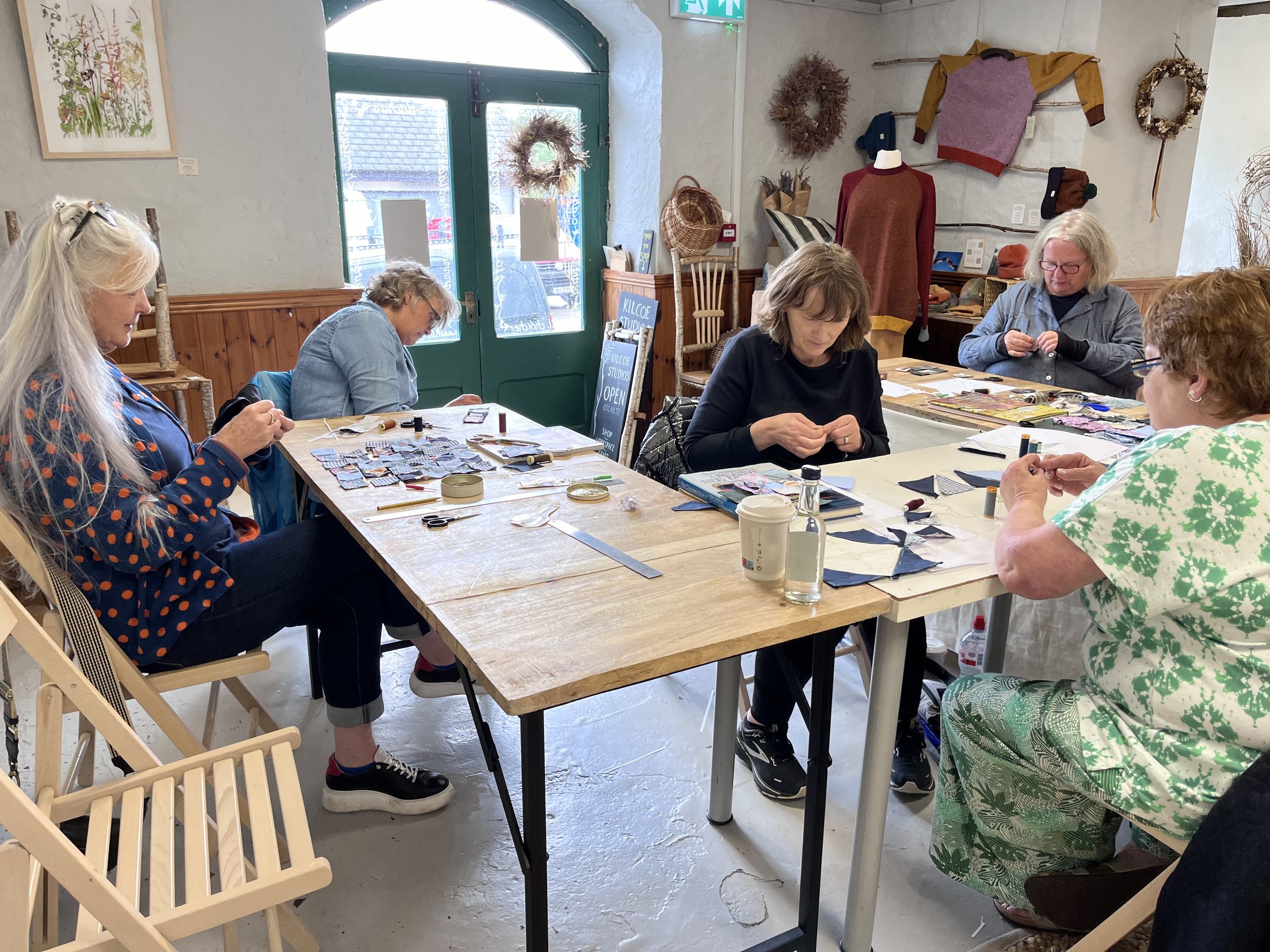When I got the email asking if I'd be interested in giving a talk to a class of students at Kinsale Community School, my instinct was, oh, I don't think I'd want to do that. Then I thought, as it's something I feel strongly around, know a little about and am trying to adopt sustainable practices in my designing and making, that maybe I should find out a bit more before hastily declining. Ms Hayes explained that her Year 2 CSPE class (that's Civic, Social and Political Education, I had to google it) had been learning about the impact of fast fashion and she was hoping to bring someone local in to talk to them.
In February, I stepped out of my comfort zone and had an amazing time with this class of informed and curious young people. The talk ranged from why clothes have become so cheap today, how the quality of clothes was better in the past, assembly line manufacturing vs making a complete garment and a bit about my own story. At the end of the talk, they had lots of great questions prepared before the bell rang and they dashed to get home. And I returned home, too, feeling unexpectedly elated and optimistic.
Carmel Somers wears the Charleville dress
Carmel Somers (front right) of Good Things Cafe, Skibbereen chose to wear the Charleville Dress at an event hosted by The Irish Times. At a gathering of top Irish chefs, the future of Irish restaurants was discussed, along with diversity in the kitchen, why there is a shortage of chefs in Ireland and the problem of no-shows.
photo credit; The Irish Times
Book | The Thoughtful Dresser By Linda Grant
Published in 2009, The Thoughtful Dresser anticipates the avalanche of disposable fast fashion and the decline in quality of the contents of our wardrobe. Linda Grant considers 'What fashion is, it's significance, and why clothes matter' as she strips back the reasons we actually wear clothes, why they matter so very much, from the practical need to cover up to protect ourselves from climate, cultural shame and personal embarrassment to the desire to adorn ourselves for the sheer pleasure of seeing ourselves transformed by fabric, the cut of a garment and it's embellishment, to dressing to send out signals about our place in the world.
As Grant explores the concepts of shopping, age appropriate clothes, shoes, handbags and the ideal body, she weaves in the compelling story of Catherine Hill, an Auschwitz survivor, who had an internationally respected career in fashion, pioneering the introduction of European fashion designers into North America. This is an enjoyable device, almost delivering two books in one, providing the reader with an individual journey of the meaning of clothes in Catherine Hill's life, parallel to a meander amongst the other themes.
The Thoughtful Dresser is an antidote to the fickle world of fast fashion as Linda Grant acknowledges our love of fashion; 'People like variety in their clothes. They want the latest fashion. This is to do with the twin desires for pleasure and for change.' She also sincerely believes, as do I, that clothes tell the story of our lives and that if you gathered together all the clothes you'd ever worn you'd have your autobiography. She talks about clothes as being a loyal comrade 'they comfort and protect us; they allow us to be who we want to be... I'm here for you, it says. Don't worry, we'll get through this day together.'.
Rarely does fast fashion hold more than a temporary position in our lives – by design, it is not made to last or has anything about it from which could develop a fond attachment. Ultimately, The Thoughtful Dresser is a reminder of how we use to think about the clothes in our wardrobe and how we valued their role, be it as clothes we could depend on to serve us whatever the occasion or a special number that would absolutely make us feel the best about ourselves. And the good thing is, we can choose to have that profound relationship with clothes once again.
Preferably, order The Thoughtful Dresser through your local independent bookshop, but it's also available on amazon.
A New Year (ethical) Resolution
Sewers (as in someone who sews) are often exceptional collectors of fabrics, trimmings and buttons and we have cherished relationships with our respective collections. I realised long ago that the enjoyment I get from acquiring new supplies and imagining what they could be made into is almost as fulfilling as completing the finished piece. Visualising options – so may possibilities! - is a necessary part of the design and planning process. It might look like daydreaming to some, but there's a lot going on behind those faraway eyes.
My own selection habits have had to sharpen up, taking into account how garments made in different fabrics have to hang together as at least some kind of coherant collection. I've had to broaden my gaze as I'm not only choosing shades that I'm personally drawn to, I need to consider colours that suit other complexions and tastes. Still, I find myself experiencing that magpie twitch when faced with a gorgeous sample of fabric or exquisite button. I'm improving at resisting the temptation of buying without knowing quite what I'm going to do with it. Without a plan, these compelling new supplies are both charged with opportunity and a rueful reminder of that already over high fabric pile.
Recently, a couple of likeminded textiles addicts have offered me lengths of fabrics that they, too, have hoarded over time. With the proviso that I'll only use natural fibre fabrics, I've acquired a new stack of small amounts of irresistible fabrics. Interestingly, these unplanned adoptions are less emotional than the ones I make on my own. Alone, I fall for colour combinations I rarely see, prints that evoke something from the past or a novelty that I think I'll never come across again. Whereas the fabrics that have been bequeathed to me, lovely as they are in their own right, present more of a design challenge to figure out how to incorporate them. The challenge of using what I already have is not only my challenge; before buying more and more, I think it's important for all of us to remember what we already have and consider if there is a way to re-purpose or re-use before opting for introducing more new material – any kind of stuff, really - into the world. To me, a resolution is a promise you make to yourself and it doesn't need to be scheduled by the commencement of a New Year. If a resolution is to be made, then make it whenever. So, my Un-New Years Resolution is to be discerning and considered with my acquisition of the new and embrace the challenge of using what already exists.
Tamsin ✂️
Contemplating an Ethical Festive Season
As the year comes to a close we find ourselves so busy, planning the time to be spent with family and friends and doing our Christmas Shopping. I know some people who totally adore the whole shebang and others who feel overwhelmed by all there is to do. As I get older, I find the last days of the year are also a time for reflection of what's passed, of where I am now and what's ahead in the new year. I know others are reflecting, too.
When it comes to sustainability, all the wheels can fall off the wagon at Christmas. Our good intentions of only buying what we need and minimising the accompanying packaging is harder to adher to. Step one is to be aware of what we're purchasing and what it's packed in; Buying something that merely has novelty factor almost guarantees it's going to end up as waste in landfill, much better to buy something that the receiver will care for and look after. Step two is to know that small changes in our purchasing habits, like remembering our bags-for-life, really do make a difference. It's about considering the choices we make and putting kindness at the centre of it all, to others, the environment and ourselves.
Have a Happy Sustainable Christmas!
Tamsin x















